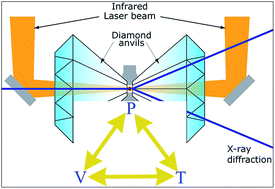In situ synchrotron X-ray diffraction with laser-heated diamond anvil cells study of Pt up to 95 GPa and 3150 K†
Abstract
Platinum (Pt) has been widely studied for pressure calibration in high pressure–temperature ranges. We have for the first time performed in situ synchrotron X-ray diffraction (XRD) with laser-heated diamond anvil cells to study the P–V–T equation of state (EOS) for Pt up to 95 GPa and 3150 K. MgO was used for pressure calibration. A detailed analysis of the room-temperature compression curve was fitted with the third-order Birch–Murnaghan (BM) EOS, which yields ambient volume V0 = 60.3 Å3, isothermal bulk modulus K0 = 308 GPa, and its pressure derivative K′0 = 4.1. A least-squares fit of the P–V–T data to a high-temperature (BM) EOS yielded K′0 = 5.5 ± 2, K0 = 274 ± 36 GPa, αKT(V0, T) = 0.003 ± 0.0003 GPa K−1 and (∂KT/∂T)V = 0.03 ± 0.01 GPa K−1 with V0 = 60.3 Å3. Within a reasonable range, it is found that the EOS of this study is consistent with the known EOS of Pt. The present technique and results cover the P–T range between the resistive heating and the shock compression experimental data in the literature.


 Please wait while we load your content...
Please wait while we load your content...